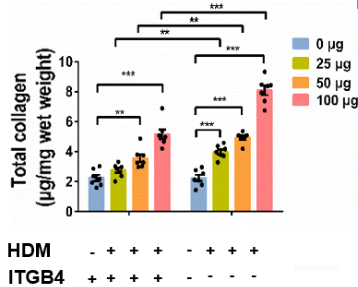Hydroxyproline (HYP) Colorimetric Assay Kit (Acid Hydrolysis Method)
SKU: E-BC-K062-M-96
To better serve you, we would like to discuss your specific requirement.
Please Contact Us for a quote.
Hydroxyproline (HYP) Colorimetric Assay Kit (Acid Hydrolysis Method)
| SKU # | E-BC-K062-M |
| Detection Instrument | Microplate reader (550-570 nm, optimum wavelength: 558 nm) |
| Detection Method | Colorimetric method |
Product Details
Properties
| Synonyms | HYP |
| Sample Type | Serum, animal tissue, urine |
| Sensitivity | 0.04 μg/mL |
| Detection Range | 0.04-10 μg/mL |
| Detection Method | Colorimetric method |
| Assay type | Quantitative |
| Assay time |
50 min |
| Precision | Average inter-assay CV: 4.400% | Average intra-assay CV: 1.200% |
| Other instruments required | Test tube, Glass tube, pH test strips. |
| Other reagents required | 6 mol/L Hydrochloric acid, Concentrated hydrochloric acid (12 mol/L), N-propyl alcohol |
| Storage | 2-8℃ |
| Valid period | 12 months |
Images
L Yuan et al investigates the airway remodeling in asthma mouse by regulating SHP2/JNK/c-Jun/FGF2 through airway epithelial ITGB4 deficiency. Hydroxyproline (HYP) of mouse lung was determined using HYP colorimetric assay kit (E-BC-K062-M).

The concentration of HYP which reflects the amount of collagen was significantly increased by HDM. (**P<0.01, ***P<0.001).
Detection Principle
The sample is hydrolyzed to generate free HYP, and hydroxyproline can produce oxidation product under the action of oxidizing agent. The generated oxidation product can react with chromogenic agent to produce burgundy. The concentration of hydroxyproline can be calculated by measuring the OD value at 558 nm.
Kit Components & Storage
| Item | Component | Size 1(48 T) | Size 2(96 T) | Storage |
| Reagent 1 | Oxidant Agent | Powder × 1 vial | Powder × 1 vial | 2-8℃, 12 months, shading light |
| Reagent 2 | Buffer Solution | 8 mL × 1 vial | 15 mL × 1 vial | 2-8℃, 12 months |
| Reagent 3 | Oxidant Agent Solvent |
8 mL × 1 vial | 15 mL × 1 vial | 2-8℃, 12 months |
| Reagent 4 | Chromogenic Agent | Powder × 1 vial | Powder × 1 vial | 2-8℃, 12 months, shading light |
| Reagent 5 | Chromogenic Agent Solvent |
28 mL ×1 vial | 52 mL ×1 vial | 2-8℃, 12 months |
| Reagent 6 | HYP Standard | 5 mg × 1 vial | 5 mg × 2 vials | 2-8℃, 12 months, shading light |
| Reagent 7 | pH Adjusting Solution A |
60 mL × 1 vial | 60 mL × 2 vials | 2-8℃, 12 months |
| Reagent 8 | pH Adjusting Solution B |
60 mL × 1 vial | 60 mL × 2 vials | 2-8℃, 12 months |
| Reagent 9 | Clarificant | Powder × 1 vial | Powder × 2 vials | |
| Microplate | 96 wells | No requirement | ||
| Plate Sealer | 2 pieces | |||
Note: The reagents must be stored strictly according to the preservation conditions in the above table. The reagents in different kits cannot be mixed with each other. For a small volume of reagents, please centrifuge before use, so as not to obtain sufficient amount of reagents.
Technical Data:
Parameter:
Intra-assay Precision
Three human serum samples were assayed in replicates of 20 to determine precision within an assay (CV = Coefficient of Variation).
| Parameters | Sample 1 | Sample 2 | Sample 3 |
| Mean (μg/mL) | 1.20 | 3.50 | 7.80 |
| %CV | 1.5 | 1.1 | 1.0 |
Inter-assay Precision
Three human serum samples were assayed 20 times in duplicate by three operators to determine precision between assays.
| Parameters | Sample 1 | Sample 2 | Sample 3 |
| Mean (μg/mL) | 1.20 | 3.50 | 7.80 |
| %CV | 4.2 | 4.3 | 4.7 |
Recovery
Take three samples of high concentration, middle concentration and low concentration to test the samples of each concentration for 6 times parallelly to get the average recovery rate of 101%.
| Standard 1 | Standard 2 | Standard 3 | |
| Expected Conc. (μg/mL) | 1.6 | 3.8 | 7.4 |
| Observed Conc. (μg/mL) | 1.6 | 3.8 | 7.7 |
| Recovery rate (%) | 99 | 100 | 104 |
Sensitivity
The analytical sensitivity of the assay is 0.04 μg/mL. This was determined by adding two standard deviations to the mean O.D. obtained when the zero standard was assayed 20 times, and calculating the corresponding concentration.
Standard Curve:
As the OD value of the standard curve may vary according to the conditions of the actual assay performance (e.g. operator, pipetting technique or temperature effects), so the standard curve and data are provided as below for reference only:
|
Concentration (μg/mL) |
0 | 1 | 2 | 3 | 4 | 6 | 8 | 10 |
| Average OD | 0.068 | 0.068 | 0.068 | 0.068 | 0.068 | 0.068 | 0.068 | 0.068 |
| Absoluted OD | 0.131 | 0.131 | 0.131 | 0.131 | 0.131 | 0.131 | 0.131 | 0.131 |



